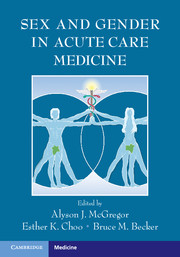Book contents
- Half title page
- Title page
- Copyright page
- Contents
- Contributors
- Foreword
- Preface
- Book part
- Chapter 1 Know the Difference: Sex and Gender in Acute Care Medicine
- Chapter 2 It’s not all Chest Pain: Sex and Gender in Acute Care Cardiology
- Chapter 3 You’ve Come a Long Way, Baby: The Effects of Sex and Gender on Asthma, COPD, Smoking, and Smoking Cessation
- Chapter 4 Sex and Gender-Specific Differences in Alcohol and Drug use Among Patients Seeking Treatment in the Acute Care Setting
- Chapter 5 Sex and Gender; Pharmacology, Efficacy, Toxicity, and Toxicology
- Chapter 6 A Sex and Gender Based Perspective on Traumatic Injury
- Chapter 7 Sex and Gender Differences in the Presentation and Treatment of Cerebrovascular Emergencies
- Chapter 8 From Title IX to the Q angle: Sex and Gender in Acute Care Orthopedics and Sports Medicine
- Chapter 9 Are Women More Sensitive? Sex and Gender Differences in Pain Perception, Clinical Evaluation and Treatment
- Chapter 10 Digesting Sex and Gender: Gastroenterology
- Chapter 11 Overcoming Resistance: Importance of Sex and Gender in Acute Infectious Illnesses
- Chapter 12 Diagnostic Imaging: Focusing a Lens on Sex and Gender
- Chapter 13 Special Populations
- Chapter 13 Special Populations
- Chapter 13 Special Populations
- Chapter 14 Sex and Gender in Medical Education: The Next Chapter
- Index
- References
Chapter 6 - A Sex and Gender Based Perspective on Traumatic Injury
Published online by Cambridge University Press: 05 May 2016
- Half title page
- Title page
- Copyright page
- Contents
- Contributors
- Foreword
- Preface
- Book part
- Chapter 1 Know the Difference: Sex and Gender in Acute Care Medicine
- Chapter 2 It’s not all Chest Pain: Sex and Gender in Acute Care Cardiology
- Chapter 3 You’ve Come a Long Way, Baby: The Effects of Sex and Gender on Asthma, COPD, Smoking, and Smoking Cessation
- Chapter 4 Sex and Gender-Specific Differences in Alcohol and Drug use Among Patients Seeking Treatment in the Acute Care Setting
- Chapter 5 Sex and Gender; Pharmacology, Efficacy, Toxicity, and Toxicology
- Chapter 6 A Sex and Gender Based Perspective on Traumatic Injury
- Chapter 7 Sex and Gender Differences in the Presentation and Treatment of Cerebrovascular Emergencies
- Chapter 8 From Title IX to the Q angle: Sex and Gender in Acute Care Orthopedics and Sports Medicine
- Chapter 9 Are Women More Sensitive? Sex and Gender Differences in Pain Perception, Clinical Evaluation and Treatment
- Chapter 10 Digesting Sex and Gender: Gastroenterology
- Chapter 11 Overcoming Resistance: Importance of Sex and Gender in Acute Infectious Illnesses
- Chapter 12 Diagnostic Imaging: Focusing a Lens on Sex and Gender
- Chapter 13 Special Populations
- Chapter 13 Special Populations
- Chapter 13 Special Populations
- Chapter 14 Sex and Gender in Medical Education: The Next Chapter
- Index
- References
- Type
- Chapter
- Information
- Sex and Gender in Acute Care Medicine , pp. 77 - 86Publisher: Cambridge University PressPrint publication year: 2016

